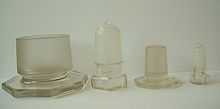Ground glass

Ground glass is glass whose surface has been ground to produce a flat but rough (matte) finish.
Ground glass surfaces have many applications, ranging from mere ornamentation on windows and table glassware to scientific uses in optics and laboratory glassware.
Uses
Photography
In photography, a sheet of ground glass is used for the manual focusing in some still and motion picture cameras, the ground-glass viewer is inserted in the back of the camera, and the lens opened to its widest aperture. This projects the scene on the ground glass upside down. The photographer focuses and composes using this projected image, sometimes with the aid of a magnifying glass (or loupe). In order to see the image better, a dark cloth is used to block out light, whence came the image of the old-time photographer with his head stuck under a large black cloth.
A ground glass is also used in the reflex finder of an SLR or TLR camera.
In motion picture cameras, the ground glass is a small, usually removable piece of transparent glass that sits between the rotary disc shutter and the viewfinder. The ground glass usually contains precise markings to show the camera operator the boundaries of the frame or the center reticle, or any other important information. Because the ground glass is positioned between the mirror shutter and the viewfinder, it does not interfere with the image reaching the film and is therefore not recorded over the final image, but rather serves as a reference for the camera operator.
Ground glasses commonly serve as a framing reference for a desired aspect ratio. Because most films shot with spherical lenses are shot full-frame and later masked during projection to a more widescreen aspect ratio, it is important not only for the operator to be able to see the boundaries of that aspect ratio, but also for the ground glass to be properly aligned in the camera so that the markings are an exact representation of the boundaries of the image recorded on film.
Lighting
Ground glass is widely used as a weather- and heat-proof light diffuser in ambient lighting, namely on glass covers or enclosures for lamp fixtures, and sometimes on incandescent bulbs. Its functions include preventing eye damage by direct looking at lamp filament, hiding unsightly details of the lamp and fixture without blocking its light, and producing a softer illumination without sharp shadows.
Chemistry
Ground glass surfaces are often found on the glass equipment of chemical laboratories.
Glass flasks, stoppers, valves, funnels, and tubing are often connected together by ground glass joints, matching pairs of conical or spherical surfaces that have been ground to a precise shape.
Flasks and test tubes often have a small ground-glass label area on the side. (Pencil writing on ground glass is largely inert, rub-proof and waterproof, but can be easily erased.)
Technical optics
Microscopes often include a ground-glass diffusing filter to generate an even illuminated field behind the specimen. Microscope slides are often ground on the sides, thus softening the edges for safer handling.
Poison
Popular belief for many centuries is that ground-up glass (i.e., glass broken into tiny fragments) can kill if swallowed. In fact, this is a myth, as it is largely ineffective.[1][2]
The Guy de Maupassant short story "La Confession" concerns a jealous girl who poisons her older sister's suitor by inserting ground-up glass into cake.[3]
See also
References
- ↑ "Pain in the Glass". Snopes. Retrieved 5 August 2013.
- ↑ Kruszelnicki, Karl. "Ground glass kills". Dr Karl. ABC Science. Retrieved 5 August 2013.
- ↑ de Maupassant, Guy. "A Sister's Confession". Retrieved 5 August 2013.
External links
- Ground glasses available from Panavision
- Ground glass focusing with the Speed Graphic
- Ground Glass focusing screens available from hopfglass
This article was originally based on "Ground glass back" in Camerapedia, retrieved at an unknown date under the GNU Free Documentation License.